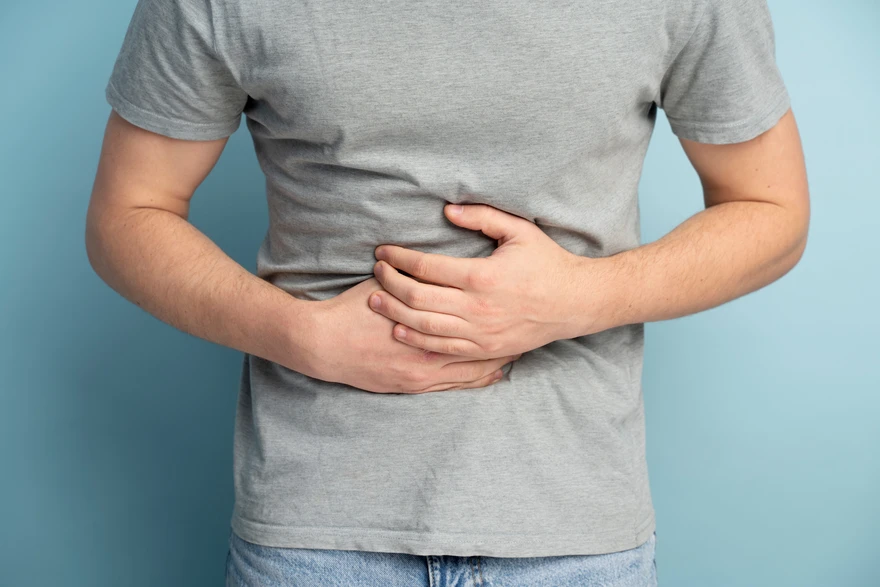Preventive Healthcare
Navigating Stomach Ulcers: Causes, Symptoms, and Treatments
10468 Views
0

Stomach ulcers are open sores that develop in the stomach lining or duodenum. The duodenum is the first part of the small intestine. Stomach ulcers are a common condition affecting millions of people worldwide.
Stomach ulcer location is usually the lining of the stomach and duodenum, which is constantly exposed to stomach acid, which helps to digest food. However, if the lining of the stomach or duodenum is damaged, stomach acid can erode the tissue and cause an ulcer.
What is a stomach ulcer?
Stomach ulcers (peptic ulcers), or gastric ulcers, are sores that develop on the stomach lining. They can be quite uncomfortable and may lead to peptic ulcer symptoms like burning stomach pain, bloating, and nausea. The bacterium Helicobacter pylori is the primary cause of stomach ulcers, but factors like long-term use of NSAIDs (nonsteroidal anti-inflammatory drugs) and excess stomach acid can also contribute.
When the mucus lining your stomach and duodenum has been worn down, stomach acids and digestive enzymes can eat away at the walls of your stomach and duodenum, leading to peptic ulcers. This ultimately leads to open sores that the acid constantly irritates. If left untreated, they may start to result in major side effects, including internal bleeding. They may even wear a hole all the way through with time. A medical emergency has occurred.
Consulting with a healthcare professional for proper diagnosis and stomach ulcer treatment is essential. If you're experiencing symptoms, don't hesitate to seek medical advice.
How common are stomach ulcers?
Stomach ulcers are a common condition, affecting about 10% of people in the United States at some point. They are more common in people over the age of 50 and in people who smoke or drink excessive alcohol.
According to the National Institute of Diabetes and Digestive and Kidney Diseases (NIDDK), about 4 million people in the United States have peptic ulcer disease, which includes stomach ulcers and duodenal ulcers.
What causes stomach ulcers?
Stomach ulcers are caused by an imbalance between the stomach lining and the digestive juices produced by the stomach. A layer of mucus protects the stomach lining, but if this layer is damaged, the digestive juices can erode the lining and cause an ulcer.
The two main causes of stomach ulcers in females and males are:
- Infection with Helicobacter pylori (H. pylori) bacteria: H. pylori bacteria are found in the stomach of about half of the world's population, but only a small percentage of people develop stomach ulcers. It is not fully understood why some people are more susceptible to H. pylori infection than others, but it is thought that genetics and environmental factors play a role.
- Nonsteroidal anti-inflammatory drugs (NSAIDs): NSAIDs are a class of drugs that are commonly used to relieve pain and inflammation. They work by blocking the production of prostaglandins, chemicals that play a role in inflammation. However, NSAIDs can also damage the stomach lining by reducing the production of mucus and increasing the production of stomach acid.
The following are less typical causes of stomach ulcers:
Zollinger-Ellison Syndrome. This is an uncommon ailment that results in excessive gastric acid production in the stomach.
High stress on the body. Stress ulcers in the stomach can result from severe illnesses, burns, or injuries. Your body's PH balance is altered by physiological stress, which raises stomach acid.
What are the symptoms of peptic ulcer disease?
The most common symptoms of peptic ulcer diseases include:
- Burning pain or sensation
- Nausea and vomiting
- Bloating
- Belching
- Loss of appetite
- Unexplained weight loss
- Black or tarry stools
- Vomiting blood or blood that looks like coffee grounds
What does a stomach ulcer feel like?
The severity of the pain can vary depending on the size and location of the ulcer. In some cases, the pain may be so severe that it wakes the person up at night. In other cases, the pain may be mild and intermittent.
A stomach ulcer can feel like a burning or gnawing pain in the upper abdomen, between the breastbone and the belly button. The pain is often worse when the stomach is empty and improves after eating. Some people may also experience nausea, vomiting, bloating, belching, loss of appetite, and unexplained weight loss.
How do you know if you have an ulcer or gastritis?
Stomach ulcers and gastritis are both conditions that can cause pain and discomfort in the upper abdomen. However, there are some key differences between the two conditions.
Stomach ulcers are open sores in the lining of the stomach or duodenum, the first part of the small intestine. Gastritis is inflammation of the lining of the stomach.
The symptoms of stomach ulcers and gastritis can be similar, but some key differences exist.
Stomach ulcers typically cause a burning or gnawing pain in the upper abdomen that is worse when the stomach is empty and improves after eating. Gastritis can cause various symptoms, including burning or aching pain in the upper abdomen, nausea, vomiting, bloating, and belching.
Another key difference between stomach ulcers and gastritis is that stomach ulcers can cause black, tarry stools, while gastritis does not. This is because stomach ulcers can bleed, which can cause the stools to turn black.
How can you tell if you have ulcer pain or heartburn?
Ulcer pain and heartburn are both conditions that can cause pain in the upper abdomen. However, there are some key differences between the two conditions.
Ulcer pain is typically a burning or gnawing pain that worsens when the stomach is empty and improves after eating.
Heartburn is typically a burning sensation behind the breastbone that worsens after eating or lying down. Acid reflux, or the reflux of stomach acid up your oesophagus, is the most common cause of heartburn. Thus, although heartburn may begin in your stomach, it will also spread upward.
Another key difference between ulcer pain and heartburn is that other symptoms, such as nausea, vomiting, bloating, and belching, can accompany ulcer pain. Heartburn is typically not accompanied by other symptoms.
Finally, ulcer pain can cause black, tarry stools, while heartburn does not. This is because ulcer pain can cause bleeding, turning the stools black.
What triggers stomach ulcer symptoms?
Stomach ulcers, which can be irritated by stomach acid, worsen after eating and when the stomach is empty. This irritation is more noticeable to some people after eating and others when not eating. Additionally, some irritants seem to exacerbate stomach ulcer symptoms and complicate their healing. The two most common ones are drinking and smoking.
What are the possible complications of peptic ulcer disease?
The following are the possible and most common complications of peptic ulcer disease (PUD):
Bleeding:
Bleeding is the most common complication of peptic ulcer disease. It can occur when an ulcer erodes a blood vessel in the stomach or duodenum. Mild bleeding may cause no symptoms, but severe bleeding can cause black, tarry stools, blood in the vomit, dizziness, and lightheadedness. In severe cases, bleeding can be life-threatening also.
Perforation:
Perforation occurs when an ulcer erodes through the stomach or duodenum wall, creating a hole. This can leak stomach acid and food into the abdominal cavity, causing inflammation and infection (peritonitis). Peritonitis is a medical emergency and requires immediate surgery.
Penetration:
Penetration occurs when an ulcer erodes through the stomach or duodenum wall and comes into contact with another organ, such as the pancreas or liver. This can cause inflammation and pain in the affected organ.
Gastric outlet obstruction:
Gastric outlet obstruction occurs when an ulcer narrows the opening between the stomach and the duodenum. This can prevent food from passing from the stomach into the small intestine. Symptoms of gastric outlet obstruction include nausea, vomiting, and bloating.
Stomach cancer:
People with PUD have a slightly increased risk of developing stomach cancer. Therefore, timely intervention is necessary.
What are the symptoms of a bleeding ulcer?
The symptoms of a bleeding ulcer can vary depending on the severity of the bleeding. Mild bleeding may cause no symptoms, while severe bleeding can cause the following common symptoms:
- Black, tarry stools
- Blood in the vomit
- Dizziness
- Lightheadedness
- Rapid heart rate
- Pale skin
- Shortness of breath
- Confusion
How is a stomach ulcer diagnosed?
There are a few different ways to diagnose a stomach ulcer. Your doctor will likely ask about your medical history and symptoms. They may also perform a physical exam. Once you have been diagnosed with a stomach ulcer, your doctor will work with you on the best stomach ulcer treatment.
What tests will be done to diagnose a peptic ulcer?
The following tests may be done to diagnose all types of peptic ulcer:
- Upper gastrointestinal (GI) endoscopy: The most accurate way to diagnose a peptic ulcer. During an endoscopy, a thin, flexible tube with a camera on its end (endoscope) is inserted through the mouth and into the oesophagus, stomach, and duodenum. This allows the doctor to see the digestive tract lining and look for ulcers.
- Barium swallow: This is an X-ray test of the upper digestive tract. The patient drinks a liquid containing barium, which coats the lining of the digestive tract and makes it visible on X-ray. This test can identify an ulcer's location and assess its size.
- Blood tests: Blood tests can be used to check for H. pylori infection, one of the common causes of peptic ulcers. Blood tests can also be used to check for anaemia, a sign of bleeding from a peptic ulcer.
- Stool test: A stool test can be used to check for H. pylori infection.
- CT- scan: A CT scan for stomach ulcers is a medical imaging test that uses X-rays to create detailed images of the stomach and duodenum. The test is used to diagnose stomach ulcers and other conditions, such as cancer, inflammation, and bleeding. During a CT scan for stomach ulcers, the patient will lie on a table, and the CT scanner will rotate around them, taking X-rays from different angles. The X-rays are combined to create a three-dimensional image of the stomach and duodenum.
- Breath Test: A breath test for PUD is based on the fact that H. pylori bacteria produce an enzyme called urease. Urease breaks down urea, a substance found in urine and other bodily fluids. When a person with H. pylori infection drinks a liquid containing urea, the urease breaks down the urea and produces carbon dioxide. The carbon dioxide is then absorbed into the bloodstream and exhaled in the breath. During a breath test for peptic ulcer disease, the patient drinks a liquid containing urea. The patient's breath is then collected in a bag and analysed for carbon dioxide. If the carbon dioxide level in the breath is high, H. pylori bacteria are present in the digestive tract.
In some cases, the doctor may also recommend a biopsy. During a biopsy, a small piece of tissue is removed from the lining of the stomach or duodenum and sent to a laboratory to be examined. A biopsy can be used to confirm the diagnosis of a peptic ulcer and to rule out other conditions, such as cancer.
How are stomach ulcers treated?
Stomach ulcer treatment is a combination of medications and lifestyle changes. The medications used to treat stomach ulcers include:
- Proton pump inhibitors (PPIs) are the most effective drugs for treating stomach ulcers. They work by blocking the production of stomach acid. PPIs are typically prescribed for 4-8 weeks, but they may be needed for longer in some cases.
- H2-receptor antagonists (H2RAs): H2RAs also effectively treat stomach ulcers. They work by reducing the amount of stomach acid produced. H2RAs are typically prescribed for 4-8 weeks, but they may be needed for longer in some cases.
- Antibiotics: Antibiotics treat stomach ulcers caused by H. pylori infection. Antibiotics are typically prescribed for 7-14 days.
- Bismuth subsalicylate (Pepto-Bismol): Pepto-Bismol coats the stomach lining and protects it from stomach acid. Pepto-Bismol is typically used in combination with other medications to treat stomach ulcers.
- Cytoprotective agent- The lining of your stomach is coated and shielded by these medications. Misoprostol and sucralfate are a couple of them.
- Over-the-counter- These effective over-the-counter medications aid in reducing gastric acid. They won't be sufficient to cure your ulcer, but they might help with alleviating some symptoms. The downside is that certain medications may also interfere with the efficacy of some antibiotics.
Conclusion
The cause of a stomach ulcer is the natural acidity of your stomach, overpowering the stomach lining's defences. If the situation isn't handled, it will only get worse. Modifying your lifestyle could be beneficial, but the underlying reason must also be treated. You can get all your peptic ulcer tests at Metropolis. Metropolis Labs is a chain of diagnostic labs across India that provide accurate blood testing and health check-up services. A team of qualified blood collection technicians make at-home visits for blood samples, which are processed at advanced diagnostic labs. The reports are shared online via email and the Metropolis TruHealth app.























 WhatsApp
WhatsApp
